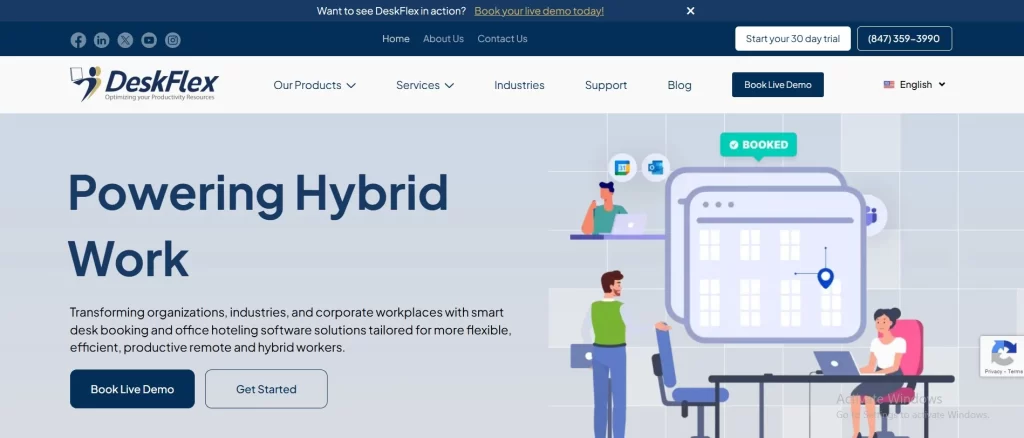
Hybrid Work Meaning: What It Is and How It Works?
The hybrid work model has gained significant traction as companies and employees alike seek more flexible and productive ways to balance work and personal life.
Blending the best of both remote and in-office work, the hybrid model allows hybrid workers to choose the work environment that suits their tasks and lifestyle while enabling businesses to optimize resources and encourage collaboration.
Unlike traditional office setups, which require employees to be on-site full-time or fully remote models that limit face-to-face interactions, hybrid work offers a middle ground.
With the hybrid approach, employees can split their time between the office and remote locations, often following a schedule or working from anywhere when their tasks demand focus.
This shift towards flexibility supports a healthy work-life balance, boosts productivity, and helps companies reduce costs associated with office space.
In this article, we’ll explore what hybrid work truly means, how it compares to other models, and how organizations can leverage its benefits.
What is Hybrid Work?
The hybrid work model is a flexible approach to working that combines both remote and in-office work. This model allows employees to choose where they work best based on their tasks, work-life balance needs, or the company’s scheduling policies.
Hybrid work is highly adaptable, meeting the needs of both individual employees and large organizations.
Companies can choose from various hybrid work arrangements based on their specific needs, creating an efficient, cost-saving solution that also fosters collaboration.
With hybrid work, employees might spend certain days in the office collaborating with their teams and other days working remotely.
This flexibility caters to different working styles and helps bridge the gap between fully remote and fully office-based setups.
How Hybrid Work Differs from Traditional and Fully Remote Work Models
The hybrid work model brings the best of both worlds, allowing employees to split their time between in-office and remote work based on specific tasks, team goals, or company policies.
This balanced approach not only fosters collaboration and engagement but also supports flexibility and cost efficiency for both employees and employers.
Traditional Office Setup
Employees work from physical office space for their full shift, promoting regular in-person interactions and team collaboration.
However, it offers limited flexibility and may not cater to employees seeking improved work-life balance or those who work best in specific environments.
Fully Remote Model
In a fully remote setup, employees work entirely from home or another location of their choice, offering maximum flexibility.
This model can, however, lead to feelings of isolation and fewer team-building opportunities, with limited spontaneous collaboration and face-to-face interaction.
Hybrid Work Model
The hybrid working model blends flexible schedules with designated in-office days, giving employees a balance of autonomy and engagement.
This approach can reduce real estate costs and support both knowledge workers and those with specific on-site needs, creating an adaptable work environment.
Organizations can implement hybrid work schedules by establishing guidelines on when employees should work in-office versus remotely.
This allows for in-person attendance at meetings and collaborative sessions while enabling focused work to be done remotely.
What are the Key Components of the Hybrid Work Model?
As more companies adopt hybrid work, they must consider which model best supports their teams, operations, and goals.
Here’s an exploration of different hybrid work models, each with unique benefits and considerations.
1. Different Types of Hybrid Work Models
Fixed Hybrid Model
This model assigns fixed days for remote work and in-office work. For example, employees might work in the office on Monday, Wednesday, and Friday and remotely on Tuesday and Thursday.
This model can simplify scheduling and ensure consistent in-person interaction on set days, fostering routine while retaining flexibility.
- Benefits: Predictable schedules, easier collaboration on in-office days
- Potential challenges: Limited flexibility for employees with varying personal commitments
Flexible Hybrid Model
Employees in a flexible model choose their work location based on their schedules, workload, or team needs. This model prioritizes individual preferences and is ideal for companies that value adaptability.
- Benefits: High employee satisfaction, supports work-life balance
- Potential challenges: Requires strong communication and coordination to avoid scheduling conflicts
Remote-First Model
In this setup, employees primarily work remotely, coming into the office only when necessary. This model supports a digital-first approach, making remote work the norm while retaining office space for specific purposes.
- Benefits: Cost savings on office space, accommodates geographically dispersed teams
- Potential challenges: Less frequent in-person interactions may impact team bonding and collaboration
Hybrid-Remote Model
This approach involves a mix of fully remote and in-office employees, allowing for overlap where necessary.
It offers flexibility for employees who prefer in-office work while also catering to those who work better remotely.
- Benefits: Supports a diverse workforce, offers flexibility based on personal needs and job roles
- Potential challenges: Coordination can be more complex, especially with varied work locations
2. Fixed Hybrid Work vs. Flexible Hybrid Work
Fixed Hybrid Work
The fixed hybrid work model has clear expectations, with employees working in-office and remotely on set days.
This approach is effective for roles requiring regular in-person collaboration but also offers the benefit of remote work to enhance flexibility and focus.
- Best fit: Structured roles with routine tasks, collaborative teams needing in-person sessions
- Challenges: Limited flexibility, the potential for misalignment with personal schedules
Flexible Hybrid Work
In contrast, the flexible hybrid model allows employees to determine where they work based on their own needs and tasks.
This model is particularly effective for knowledge-based roles where individual focus is as important as team collaboration.
- Best fit: Roles requiring high autonomy, dynamic work environments with varied tasks
- Challenges: Requires coordination to ensure productivity and engagement, reliance on communication tools
To decide between a fixed or flexible hybrid model, companies should consider employee preferences, project demands, and team collaboration needs.
While fixed models provide routine, flexible models enhance autonomy, making each suitable depending on a company’s goals and work culture.
3 Benefits of Implementing a Hybrid Work Model
The hybrid work model offers a range of advantages for both employees and organizations, balancing flexibility with productivity. Here’s a closer look at the key benefits:
1. Enhanced Work-Life Balance for Employees
The flexible work model allows employees to enjoy a balanced work-life structure by offering the flexibility to work from home or in the office.
With the choice of location, employees can tailor their workdays to fit personal responsibilities and work demands, creating a healthier balance between the two.
- Flexibility for personal eesponsibilities: Employees can manage family obligations, health appointments, or household tasks more efficiently, which reduces stress and makes it easier to be present and productive.
- Improved physical and mental health: This balance supports mental wellness by reducing burnout and providing employees with more control over their work environments.
- Long-term retention: Companies that promote work-life balance through hybrid options are more likely to retain talent, as flexibility is a top priority for many employees today.
2. Employee Productivity and Engagement
Hybrid work models grant hybrid and remote workers greater autonomy, which has been linked to higher productivity, employee engagement, and job satisfaction.
With the freedom to choose where and how they work, employees can match their environment to the demands of their tasks, leading to more effective outcomes.
Giving employees control over their schedules and locations encourages accountability and focus, which drives productivity.
Employees who feel trusted to manage their own time tend to be more engaged and motivated, contributing positively to their roles and team morale.
Access to both remote and in-office spaces supports a variety of working styles. Employees can work remotely for deep focus and come into the office for collaborative sessions, benefiting from the best of both worlds.
3. Cost Savings and Real Estate Benefits for Companies
For companies, the hybrid work model and hybrid work schedule reduce the need for extensive office space, resulting in significant cost savings.
Many organizations are finding that they can maintain productivity and employee satisfaction while reducing their physical footprint.
- Reduced office footprint: Fewer employees working in-office every day means less need for dedicated desks, allowing companies to downsize or redesign their spaces.
- Lower overhead costs: With fewer people in the office, companies save on utilities, office supplies, and maintenance expenses, reducing operational costs.
- Flexible office space: Companies can repurpose or convert traditional office layouts into collaborative spaces, enhancing teamwork and accommodating hybrid schedules. This adaptability can also support the future growth of a business without requiring additional real estate investment.
The hybrid model, by enhancing work-life balance, boosting productivity for hybrid employees, and reducing real estate costs, creates a sustainable office solution for modern workplaces.
It aligns employee preferences with organizational needs, resulting in a flexible, efficient, and supportive work environment.
Key Features to Look for in Hybrid Work Solutions
Choosing the right hybrid work tools can make or break the success of hybrid workplaces and the overall hybrid work model.
Below are essential features to consider when selecting hybrid work solutions that enhance flexibility, security, and productivity.
1. Scheduling and Reservation Tools
Scheduling and reservation tools are central to managing a hybrid office. They allow employees to book desks, meeting rooms, and even hot desks, ensuring a smooth flow in the workplace.
With real-time availability, these tools enable employees to reserve spaces on demand, preventing conflicts and optimizing office space utilization.
2. Collaboration Tools and Communication Platforms
Effective communication and collaboration tools are key in a hybrid work model. Solutions that include file-sharing, task management, and video conferencing capabilities ensure that remote and in-office teams stay connected and productive.
Recommended options like DeskFlex, Zoom, Google Workspace, and Asana enable teams to collaborate in real time, track project milestones, and access shared documents effortlessly.
3. Security and Privacy Features
Security is paramount in hybrid work, as employees may work from various locations and networks. Look for features like VPN access, secure login protocols, and data encryption to protect sensitive information.
Ensuring compliance with data privacy standards, such as GDPR, is also essential for safeguarding both company and employee data.
4. Analytics and Performance Tracking
To make the most of a hybrid workspace, analytics and performance tracking tools provide valuable insights. Office usage reports help facilities managers understand occupancy rates, allowing them to adjust layouts as needed.
Tracking employee productivity and engagement metrics helps managers gauge whether the hybrid model is meeting team goals.
How to Implement a Hybrid Work Model for Your Business
Transitioning to a hybrid work model involves careful planning, aligning employee input with company goals, and choosing the right tools to support both remote and in-office teams.
Here’s how to approach each key area.
1. Assess Employee Needs and Preferences
Successfully implementing a hybrid work model starts with understanding employee needs. Conducting surveys and feedback sessions can reveal employee priorities around flexibility, work-life balance, and workplace resources.
Balancing these insights with company productivity goals ensures that flexibility supports rather than hinders performance.
2. Establish Hybrid Work Policies
Clear, structured policies define expectations for both remote and in-office days, setting a foundation for accountability, smooth operations, and a strong company culture.
Outlining specific days for remote and on-site work—whether flexible or fixed—gives employees a clear schedule to work within.
3. Design an Effective Hybrid Workplace
An effective hybrid workplace is designed to support different working styles, combining quiet zones for focused tasks, collaborative areas for teamwork, and flexible desk options for hybrid schedules.
For example, by designating specific zones for different activities, the office layout can better accommodate varied tasks, reducing interruptions and increasing comfort for employees.
4. Choose the Right Hybrid Work Tools and Software
Selecting technology that fosters flexibility and communication is essential for an effective hybrid workforce. Look for tools that offer scheduling, real-time availability,virtual conference one time room collaboration, and task management to streamline workflows across locations.
Compatibility with existing platforms, like Microsoft Teams or Google Workspace, also allows for a smooth transition without disrupting established workflows.
Optimize Your Hybrid Work Space with DeskFlex

With features like desk booking, meeting room reservations, and real-time workspace availability, DeskFlex helps hybrid teams stay organized and productive.
It integrates with Microsoft Teams and Zapier integration, ensuring your team can workspace collaborate tools effortlessly and keep their schedules in sync.
Additionally, its interactive floor plans and analytics tools allow facilities managers to make informed decisions, enhancing office space utilization and reducing operational costs.
For organizations aiming to balance flexibility with structure in a hybrid model, DeskFlex provides an easy-to-use platform that adapts to your team’s needs.
Explore how DeskFlex can streamline your hybrid work setup and you can book a free demo today!
FAQs About Hybrid Work Meaning
What is the difference between remote and hybrid jobs?
In remote jobs, employees work entirely outside the office, often from home or a location of their choice, with little or no requirement to be in person. In contrast, hybrid jobs allow employees to split their time between remote and in-office work, offering flexibility to adapt their location based on the day or task.
How many days a week is hybrid work?
Hybrid work schedules can range from one to several days in the office, depending on the company’s policy. Commonly, companies set specific office days (e.g., three in-office days and two remote days), but some models offer employees more flexibility in choosing their in-office days.
What is the difference between on-site hybrid and remote?
In-person interaction and remote flexibility offer distinct work experiences. In remote roles, employees work entirely off-site without any scheduled requirement to be in the office, providing high flexibility but limiting opportunities for in-person interaction.
What is hybrid working in job descriptions?
In job descriptions, “hybrid working” indicates a flexible working arrangement where employees can work both remotely and in the office. Hybrid roles may specify office attendance expectations (e.g., specific days or meetings) or allow employees to set their schedule in consultation with their team.
How can companies ensure data security in a hybrid work environment?
Companies can ensure data security in a hybrid work environment by using VPNs, implementing multi-factor authentication, and regularly updating software to patch vulnerabilities. Training employees on cybersecurity best practices, securing endpoint devices, and encrypting sensitive data further help protect company resources and maintain security across remote and in-office locations.















































 Support
Support  Demo
Demo  Blog
Blog 